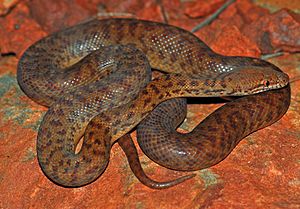Pygmy python facts for kids
Quick facts for kids Pygmy python |
|
|---|---|
 |
|
| Conservation status | |
| Scientific classification | |
| Genus: |
Antaresia
|
| Species: |
perthensis
|
| Synonyms | |
|
|
The pygmy python (Antaresia perthensis) is a small snake found in Western Australia. It's also called the anthill python. These names describe the snake well! "Pygmy" means it's the smallest type of python in the Pythonidae family. "Anthill" comes from where it often lives: inside termite mounds.
The scientific name, perthensis, comes from Perth, the capital city of Western Australia. However, it's a bit of a mistake because these snakes don't actually live in Perth. No different types (subspecies) of the pygmy python are known at this time.
Contents
What Does the Pygmy Python Look Like?
Adult pygmy pythons usually grow to about 50 centimeters (20 inches) long. They weigh around 210 grams (about 7.4 ounces). When they are first born, they are tiny, only about 8 centimeters (3 inches) long and weigh about 4 grams (0.14 ounces). After a year, they might weigh around 25 grams (0.9 ounces).
This makes them smaller than other pythons like the Children's python (A. childreni) and the spotted python (A. maculosa). Pygmy pythons often have a reddish color on their bodies. Their spots tend to fade as they get older. In contrast, the Children's and spotted pythons have lighter body colors, and their spots stay clear throughout their lives.
Where Do Pygmy Pythons Live?
Pygmy pythons are found in the northwest part of Western Australia. They also live on some islands along the coast. The first place recorded where a pygmy python was found was "Perth, West Australia." But this was a mistake! Scientists now know that the exact original location where the first specimen was collected is unknown.
Caring for Pygmy Pythons in Captivity
Pygmy pythons are popular as pets. Because they are so small, they don't need a very big space. A small tank, like one that holds 5.5 gallons, can be enough for them. Special reptile homes are best, but a simple fish tank can work for a while.
They usually eat mice as their main food. Sometimes, they can also eat small "fuzzy" rats. Giving them food that is too big can stress them out, even if they try to eat it. Once a pygmy python starts eating regularly, it rarely refuses a meal. The only times they might not eat are during breeding season or when they are shedding their skin. Even after about six months, they are still very light, showing how small they stay.
Pygmy Python Life Cycle and Reproduction
Pygmy pythons lay eggs. This means they are oviparous. A female pygmy python usually lays a clutch of 5 to 8 eggs. After laying her eggs, the female snake will coil around them. She lifts the eggs slightly off the ground and keeps them warm until they hatch. The eggs usually hatch after about 50 to 60 days.
Images for kids



